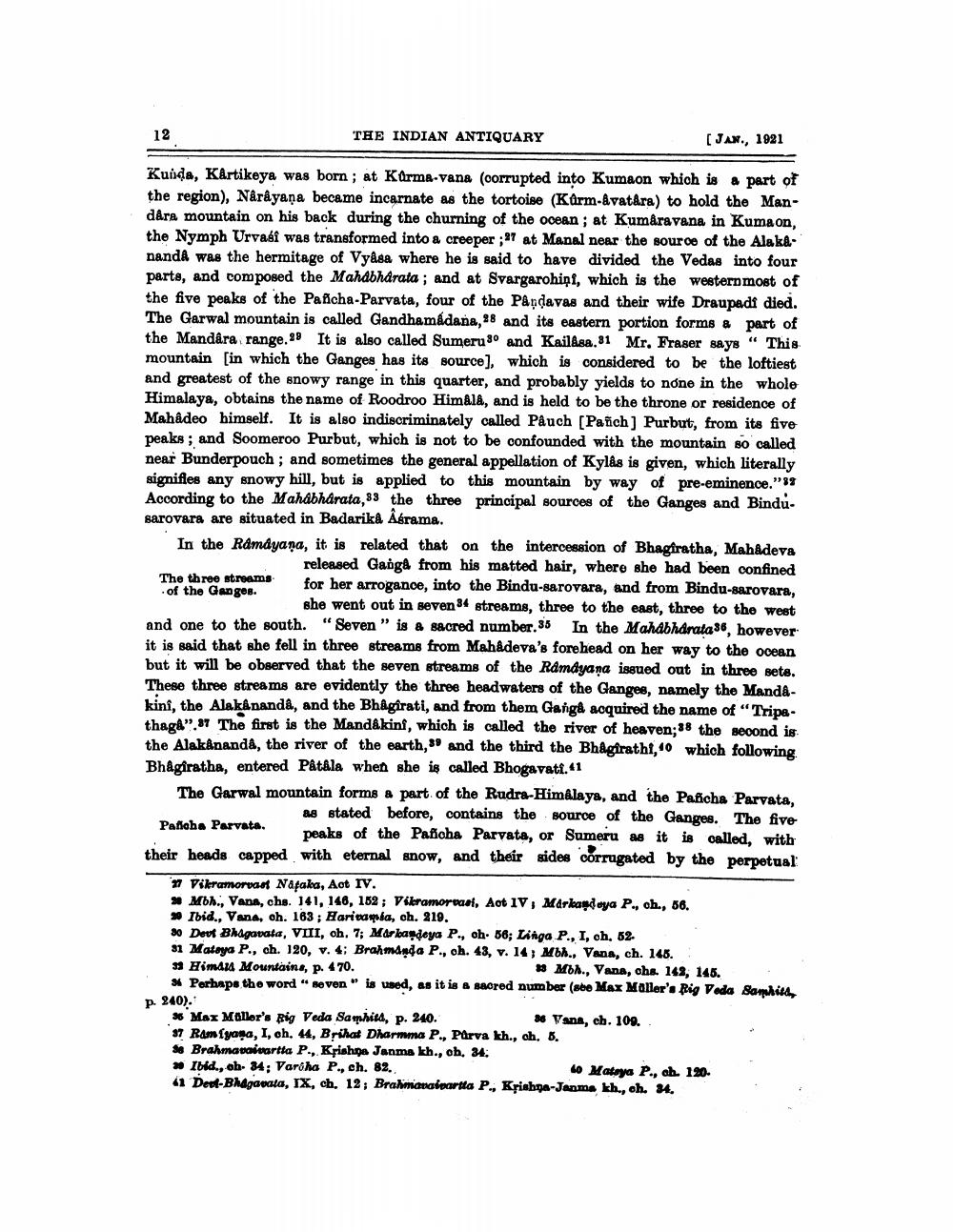________________
THE INDIAN ANTIQUARY
[JAN., 1921
Kuida, Kartikeya was born ; at Karma-vana (corrupted into Kumaon which is a part of the region), Narayana became incarnate as the tortoise (Karm-avatara) to hold the Mandåra mountain on his back during the churning of the ocean; at Kumaravana in Kumaon, the Nymph Urvasi was transformed into a creeper :97 at Manal near the source of the AlakanandA was the hermitage of Vyasa where he is said to have divided the Vedas into four parts, and composed the Mahabharata ; and at Svargarohiņi, which is the westernmost of the five peaks of the Pafcha-Parvata, four of the Pandavas and their wife Draupadi died. The Garwal mountain is called Gandhamádana, 28 and its eastern portion forms a part of the Mandâra range.99 It is also called Sumeru 30 and Kailasa, 31 Mr. Fraser says " This mountain (in which the Ganges has its source], which is considered to be the loftiest and greatest of the snowy range in this quarter, and probably yields to none in the whole Himalaya, obtains the name of Roodroo Himala, and is held to be the throne or residence of Mahadeo himself. It is also indiscriminately called Pauch (Parich) Purbut, from its five peaks ; and Soomeroo Purbut, which is not to be confounded with the mountain so called near Bunder pouch ; and sometimes the general appellation of Kylas is given, which literally signifies any snowy hill, but is applied to this mountain by way of pre-eminence.”39 According to the Mahabharata,83 the three principal sources of the Ganges and Bindusarovara are situated in Badarika Asrama. In the Ramayana, it is related that on the intercession of Bhagiratha, Mahadeva
released Ganga from his matted hair, where she had been confined The three streams for her arroganoe, into the Bindu-sarovara, and from Bindu-sarovara, of the Ganges.
she went out in seven 34 streams, three to the east, three to the west and one to the south. "Seven" is & sacred number.36 In the Mahabharata 36, however it is said that she fell in three streams from Mahadeva's forehead on her way to the ocean but it will be observed that the seven streams of the Ramdyana issued out in three sets. These three streams are evidently the three headwaters of the Ganges, namely the Mandakini, the Alakknanda, and the Bhagirati, and from them Gangå acquired the name of "Tripethaga.".37 The first is the Mandakini, which is called the river of heaven;38 the second is the Alakananda, the river of the earth, and the third the Bhagirathi, which following Bhagiratha, entered Påtala when she is called Bhogavati. 41 The Garwal mountain forms a part of the Rudra-Himalaya, and the Pascha Parvata,
as stated before, contains the source of the Ganges. The five Patlaba Parvata.
peaks of the Pafioha Parvata, or Sumeru as it is called, with their heads capped with eternal snow, and their sides corrugated by the perpetual
1 Vikramorvat Napaka, Aot IV. » Mh., Vana, chs. 141, 148, 162; Vikramornari, Aot IV, Markandeya P., oh., 66. * Ibid., Vana, oh. 163: Harisaqola, oh. 219. 20 Deuf Bhagavata, VIII, oh, 7; Marlar deya P., oh. 56; Linga P., I, ch. 5231 Matsya P., ch. 120, v. 4; Brahmanda P., ch.43, v. 14; Mbh., Vana, ch. 145. 3 Himau Mountains, p. 470.
# Mbl., Vana, cha. 142, 146. si Perhaps the word " novon " is used, as it is & sacred number (sbe Max Moller'. Rig Veda Samhill p. 240). 3 Max Mallor's Rig Veda Samhita, p. 240.
36 Vana, ch. 109. '37 Ram yana, I, oh, 44, Brihat Dharmma P., Parva kh., ch, B. * Brahmavaivartta P., Krishịa Janma kh., ch. 24. * Ibid., oh- 84; Varsha P., ch. 82.
40 Matsya P., sh. 120. 41 Deut-Bhagavata, IX, ch. 12; Brahmanaipartta P., Krishna Janma kh., oh. 34.




